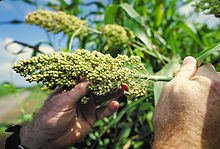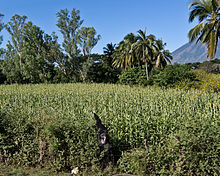
Sorghum
Background Information
SOS Children offer a complete download of this selection for schools for use on schools intranets. SOS mothers each look after a a family of sponsored children.
| Sorghum | |
|---|---|
 |
|
| Scientific classification | |
| Kingdom: | Plantae |
| (unranked): | Angiosperms |
| (unranked): | Monocots |
| (unranked): | Commelinids |
| Order: | Poales |
| Family: | Poaceae |
| Subfamily: | Panicoideae |
| Tribe: | Andropogoneae |
| Genus: | Sorghum L. |
| Species | |
|
About 30 species, see text |
|
Sorghum is a genus of numerous species of grasses, one of which is raised for grain and many of which are used as fodder plants, either cultivated or as part of pasture. The plants are cultivated in warmer climates worldwide. Species are native to tropical and subtropical regions of all continents in addition to the southwest Pacific and Australasia. Sorghum is in the subfamily Panicoideae and the tribe of Andropogoneae (the tribe of big bluestem and sugar cane).
Cultivation and uses

One species, Sorghum bicolor, is an important world crop, used for food (as grain and in sorghum syrup or "sorghum molasses"), fodder, the production of alcoholic beverages, and biofuels. Most varieties are drought- and heat-tolerant, and are especially important in arid regions, where the grain is one of the staples for poor and rural people. These varieties form important components of pastures in many tropical regions. Sorghum bicolor is an important food crop in Africa, Central America, and South Asia and is the "fifth most important cereal crop grown in the world".
Some species of sorghum can contain levels of hydrogen cyanide, hordenine and nitrates lethal to grazing animals in the early stages of the plant's growth. When stressed by drought or heat, plants can also contain toxic levels of cyanide and/or nitrates at later stages in growth.
Another Sorghum species, Johnson grass (S. halapense), is classified as an invasive species in the US by the Department of Agriculture.
Sorghum vulgare var. technicum is commonly called broomcorn.
Sorghum genome
In 2009, a team of international researchers announced they had sequenced the sorghum genome.
